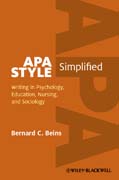
APA style simplified: writing in psychology, education, nursing, and sociology
Beins, Bernard C.
This is a compact but comprehensive guide to writing clearly and effectively in APA style.Demonstrates how to write objective scientific research papers using interesting proseIncorporates guidelines from the 6th edition of the APA publication manualExplores how to develop ideas, connect them to what others have written, and express them clearlyDiscusses the differences between written,oral, and poster presentations and offers instructions for applying APA styleto each INDICE: Preface viiiAcknowledgments xi1 Writing Professionally 1How Does Professional Writing Differ From Other Kinds of Writing? 2Using APA Style 3Making a Credible Argument 5Different Types of Communication 6Effective Communication 8Establishing Good Writing Habits 9Ethical Writing 102 Elements of Style 15Recognizing the Importance of Good Grammar and Style 16Choosing Effective Wording 17Using Inclusive and Appropriate Language 19Deciding on the Use of Technical Language 20Avoiding Common Problems 21Verb Forms 24Spelling 25Specific Word Use 253 The Introduction Section 32Introducing the Topic 33Different Approaches to Starting the Introduction 34How to Begin 38Reviewing the Literature 38Introducing Your Research: Generating a Hypothesis 404 The Method Section 43Participants and Subjects 44Materials and Apparatus 52Procedure 56Design 585 Communicating Statistics 59Why Do We Use Statistics? 60What Point Are You Trying to Make? 61Understanding Your Numbers 63Helping Readers Understand Your Statistics 65Differentiating Results and Interpretations 686 The Results Section 69Your Hypothesis 70Deciding What to Present 71APA Style and Presentation of YourResults 74Creating Tables 77Creating Figures 82The Connection Between the Text and the Tables and Figures 87The Difference Between Results and Discussion Sections 87Some Final Points About Presenting Results 887 The Discussion Section 91Summarizing Your Results 92Connecting Different Aspects of Your Results 94Dealing With Nonsignificant Results 95Comparing Your Results With Those of Others 96Stating the Importance and Implications of Your Results 97Acknowledging the Limitations of Your Study 988 References: Citations in the Text and the Reference List 100Citing References in the Text 101Order of Citations in the Reference List 105Using Your Word-Processing Program to Create the Citation 105Examples of How Different Types of References Should Be Laid Out 1069 Final Touches: The Abstract and Formatting Details 114The Abstract 115Formatting Your Manuscript 11610 Creating Poster Presentations 135Differentiating Visual and Written Communication 135Reducing the Amount of Information 136Visual Style 137Your Behavior: The Ethic of a Poster Session 142Creating Your Poster Using PowerPoint 14411 Giving Oral Presentations 152The Difference Between Oral and Written English 152Adapting APA Style to Oral Presentations 156Preparing for Your Talk 157Creating Graphics for Your Presentation 159Giving the Presentation 16012 Sharing Your Work Electronically 163New Capabilities in Electronic Sharing 164Using a Word Processor to Create Manuscripts for the Internet 165Advantagesof Internet Publishing Software 167Publishing Your Poster on the Web 169Uploading Your Manuscript to the Internet 169Revisiting the Concept of Plagiarism 170Appendix A: Example of APA-Style Manuscript withCommon Errors 171Appendix B:Corrected APA-Style Manuscript 179References 188Name Index 195Subject Index 198
- ISBN: 978-0-470-67232-7
- Editorial: John Wiley & Sons
- Encuadernacion: Cartoné
- Páginas: 216
- Fecha Publicación: 13/04/2012
- Nº Volúmenes: 1
- Idioma: Inglés
